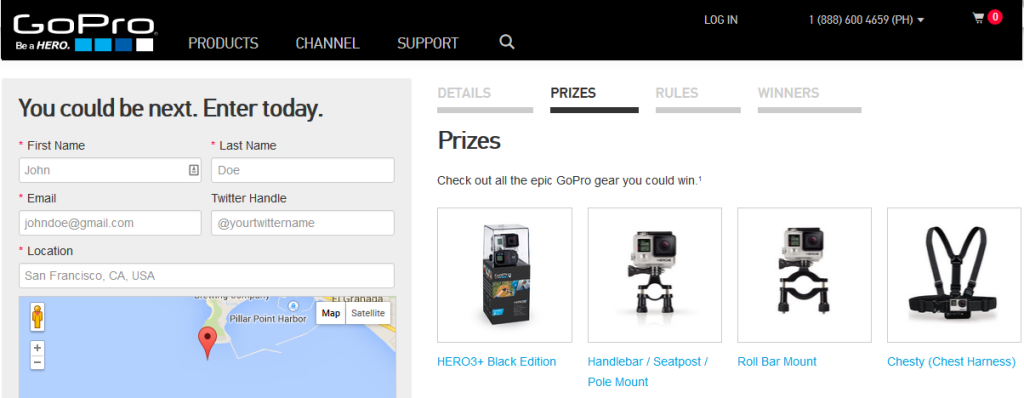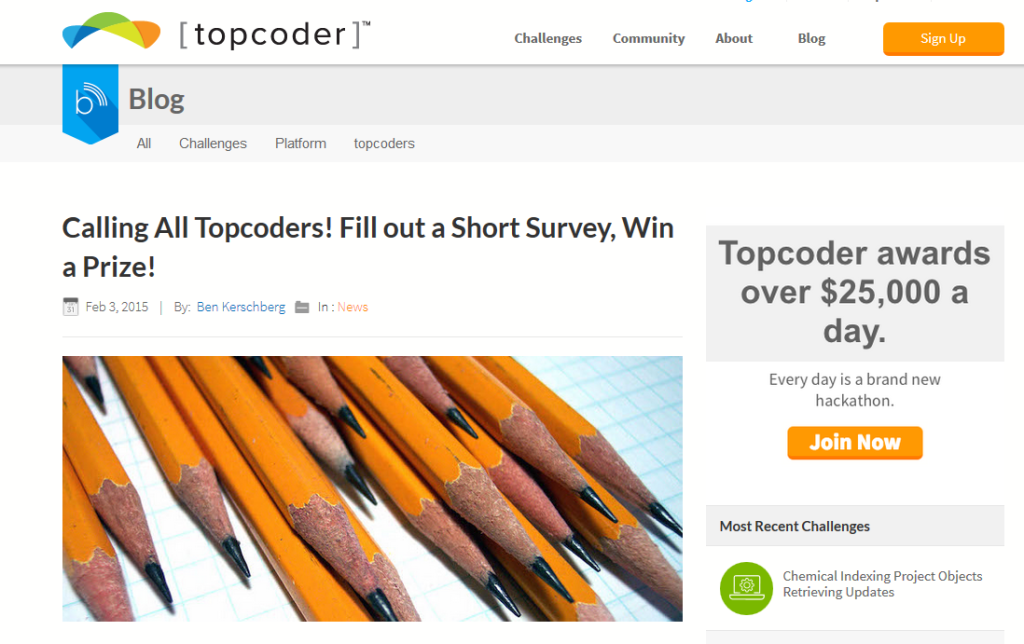Advertising legend David Ogilvy once said that “On average, five times as many people read the headline compared to the body copy. When you have written your headline, you have spent eighty cents out of your dollar.”
Headlines create clarity.
They create curiosity.
When done right they compel clicks.
This simply means that you have to pay very close attention to your headline. Most of the dollars you pay for getting customers and receiving an ROI starts here.
People click on attention grabbing headlines.
Even crappy blogs get the click as long as there’s a headline that’s worth clicking. Of course, it’s way better to have a powerful duo of a great headline and awesome content. But it starts with the headline.
If you’re doing any form of marketing, whether it be content, paid, email or any other channel, then a good headline is your first chance to get it right (or wrong).
Your Words Have Power
In 1963, Ogilvy published a list of 20 most persuasive words in advertising. Marketers still use these words now. The list includes:
suddenly
now
announcing
introducing
improvement
amazing
sensational
remarkable
revolutionary
startling
miracle
magic
offer
quick
easy
wanted
challenge
compare
bargain
hurry
Articles, copy, email subject lines, social sharing posts; they are used all the time.
These words describe time, emotion/feeling and need.
You see many headlines that are still using these words because it triggers something in your psyche.
How? Here’s a good take backed by science.
The Science Behind a Click-Worthy Headline
Words have power. But they cannot make your customers act unless they touch a nerve, in a good way. There are words that we consider power words, but even words that are not powerful enough can get your message across using a subtle nudge.
What I’m saying is that, science and psychology has something to do with how your customers react when they see your headline – whether it’s using powerful or not-so-powerful words.
While your customers’ psyche is complicated, you can make it work to your advantage. Courtney Seiter highlighted these eight winning formulas and the science behind them, so you can craft your words in such a way that it will trigger your customers to click.
A quick overview, the following include:
1. Surprise
Based on a study, unexpected surprises are more stimulating to the brain. It grabs attention compared to things that we already know.
2. Questions
Questions stimulate the brain to look for answers. So when you use a question in headlines, readers can’t help but jump in to find out the answer.
3. Curiosity
Upworthy created a buzz when they started creating brilliantly made headlines. Why brilliant? Well people click on them. People are curious about what they were talking about. They tell something about the content but not enough to fully disclose what has happened. They call this curiosity gap.
4. Negatives
Outbrain conducted a study and found out that negative superlatives have stronger impact than positive ones. Theories including negative are more intriguing because they are unexpected and activate an element of surprise. Another is that, they tap into our insecurities in a powerful way.
5. How To
“How to” simplifies things. You can do a lot of variations, but when you use this, you can’t go wrong with your headline.
6. Numbers
This is all about predictability and expectations. It’s all about managing expectations so your customers know what they are getting into.
7. Audience Referencing
People like to involve themselves. Using the word “you” is a good way to do that. Your audience feels a certain connection when you use it.
8. Specificity
Specific facts stick in the mind. It’s interesting to many people because they lead to greater clarity.
Writing Your Headline: How Do You Even Begin?
Many have created secret formulas and weird concoctions to come up with different types of headlines that’s worthy of clicking and sharing. Clayton Makepeace simplified the process by asking these six questions when you want to write a power-packed headline:
1. Does your headline offer the reader a reward for reading?
2. What specifics could you add to make your headline more intriguing and believable?
3. Does your headline trigger a strong, actionable emotion the reader already has about the subject at hand?
4. Does your headline present a proposition that will instantly get your prospect nodding his or her head?
5. Could your headline benefit from the inclusion of a proposed transaction?
6. Could you add an element of intrigue to drive the prospect into your opening copy?
These questions can guide you to include all the necessary elements to make your headline clickable.
25 Headline Formulas that you can Try Today
At Growth HQ, we have gathered some of the best headline formulas and shared them to get you started. Here are some of them.
Negative/Threatening Headline
Negatives get into the subconscious. They create a reflex action to find how the threat or negativity can be neutralised. That’s why people click on these kinds of headlines.
1. Lies that [Trusted Company/People] Tell You
Example: Lies that Your Doctor Tells You
2. [Threat]: [Negative Superlative] + [Action]
Example: Lie: Worst Thing to Do When Selling
3. [People/Organisation] + [Action] + [Threat]
Example: If You are Spending on Marketing, You Will Go Out of Business
4. Warning Signs that [Subject/Product/Event] is a Scam.
Example: Warning Signs that ETrade Expo is a Scam
Headlines that Ask Questions
5. According to Ian Betteridge, any headline that ends in a question mark can be answered by no. So you have to be very crafty and creative when using this formula. To make this work though, why not try adding another headline.
Example: Are you going to get rich by selling this product? Yes, if You Do this Steps.
Guide Type Headline
6. The classic “How to” headline is the best default you can use. No matter how creative you think other headline formulas are, you are probably better off using the “how to” headline. First of all, it is easy to come up with a strong and attention grabbing headline using this technique.
Example: How to Get Thousands of Traffic in 60 Days
7. The ultimate list is something that we also love. It immediately tells us that we can find good stuff in there.
“The Ultimate Guide to [—–]”
E.g. The Ultimate List of Growth Hacker Blogs
8. This kind of headline attracts many first timers.
“The Beginner’s Guide to [——]”
9. Starting an epic list post? Then you need an epic headline.
The Big List of [——] or The Complete List of [—–]
Example: The Complete List of Gory Scenes in Game of Thrones
10. People love instant solutions. That’s why headlines with quick solutions are easy clickbait items.
Example: Here’s a Quick and Easy Way to Solve Writer’s Block
11. Need a good list of rules? Do’s and Don’ts can do the job.
[Action] Do’s and Don’tExample: Sleeping Do’s and Don’ts
Number/List Headline Formula
12. If you want an eye catching headline with a compelling promise, you can try Kozaii Marketing’s Lenka Istvanova’s formula.
[Numbers] + [Adjective] + [Target Keyword] + [Rationale] + [Promise]Example: 25 Greatest Life hacks that will Cut your Work in Half.
13. List articles are the most powerful blog posts you can do if you want page views. Using a list type headline and followed by lessons you learned is very seductive to your reader’s senses.
Example: 10 Lessons I Learned from Reading Twilight
14. Use powerful adjectives and paint a picture with nouns. Jeff Goins believes in using the right words for your headline.
[Number or Trigger word] + [Adjective] + [Keyword] + [Promise]Example: 10 Terribly Useful Copywriting Techniques to Supercharge your Blog Post
Headline with Social Proof, Recommendation or Backed by Science
15. Recommendations convey trust. That is why headlines using this technique get high open rates.
Example: 10,000 Customers of Starbucks said this ….
16. Social proofing is one thing, scientific proof is another. The “backed by science” headline is compelling for people who are logical. Some people are interested about facts and data more than stories.
Example: How to be Happy: The 5 Greatest Happiness Hacks You’ll Ever Need, Backed By Science
17. For a headline that prominently features social proofing – here is a good formula ad used by John Caples, author of testing advertising methods.
Who else [Action] + [Promise]?
Example: Who else wants to earn six figures using a proven system?
Mini or Zen Headline
18. Our brain immediately pushes that button in us when something intriguing gets our attention. It tells us to click that headline and get into the bottom of that secret. So we click away.
Example: The Secret of [——-]
19. The mini headline is about 4 words or less. This headline formula was popularized by Leo Babauta of Zen Habits. Why is it powerful? Because it creates a sense of mystery that makes the reader curious to read more about the headline.
Example: In Praise of Limit
SEO Charged Headline
20. Of course we don’t discount seo when creating headlines. It’s still necessary for search but you can use this formula to give your title some personality.
[Adjective] + [SEO Keyword] + [Promise]Example: Great Content Marketing Strategies to Boost Your Sales up to 500%
Combo Headline
21. This makes a rather long headline but it does the job. Just check out this headline from Kevan Lee.
Example: The Burrito Principle and Beyond: 12 New Marketing Ideas That Are Memorable, Actionable and Useful
Other Headlines that are Worth Trying
22. If you want to use a headline where you intend to inspire your reader to achieve something greater than what they think they are capable of, then you can use this formula:
How to [do whatever] like [example of world class personality] without [something negative]
Example: How to Write Copy Like a Rockstar without any Formal Training
23. Another great headline technique is to use a colon in your headline to create a little bit of spice and avoid monotony in your writing.
Example: Buyer Persona: How to Make Your Customers Tick
24. The SHINE headline is something developed by the Braintrust of KISSmetrics. I’d like to borrow and share this formula with you because of its usefulness.
S – Specificity
H – Helpfulness
I – Immediacy
N – Newsworthiness
E – Entertainment value
Example: How to Write a Blogpost in 5 Minutes or Less Using Twitter as a Research Tool
25. Niche or Industry Specific
Industry specific headlines are great when you have a highly-targeted audience.
What [your industry or niche people] + [Adjective/Adverb] + [Action]
Example: What First Time Marketers Stupidly Sell Online
What next?
Headline formulas are good way to start. Remember though that there’s always some room to break the rules. It’s best to think of your target market and use words that trigger an emotional response from them.
Need help triggering response from your target market and becoming No. 1 in your marketplace? Download our FREE BOOK and find out our strategies for getting to number one online.
If you want help formulating a killer headline then leave a comment and we will hand you one on a plate.

















